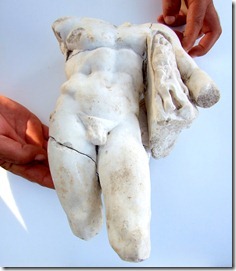The Israel Antiquities Authority has announced the discovery of a headless statue of Hercules at a site 3 miles (4 km) northwest of Afula in the Jezreel Valley. From the press release:
A rare statue of Hercules was exposed at Horvat Tarbenet in the Jezreel Valley in excavations of the Israel Antiquities Authority, within the framework of the Jezreel Valley Railway project, directed by the Israel National Roads Company
A marble statue of Hercules from the second century CE was uncovered in excavations the Israel Antiquities Authority is conducting at Horvat Tarbenet, within the framework of the Jezreel Valley Railway project, directed by the Israel National Roads Company.
According to Dr. Walid Atrash of the Israel Antiquities Authority, “This is a rare discovery. The statue, which probably stood in a niche, was part of the decoration of a bathhouse pool that was exposed during the course of the excavations. It is c. 0.5 m tall, is made of smoothed white marble and is of exceptional artistic quality. Hercules is depicted in three dimension, as a naked figure standing on a base. His bulging muscles stand out prominently, he is leaning on a club to his left, on the upper part of which hangs the skin of the Nemean lion, which according to Greek mythology Hercules slew as the first of his twelve labors”.
The press release continues here. Three (similar) photos of the statue are available in a zip file.
UPDATE (8/16): The story is reported in the Jerusalem Post.
